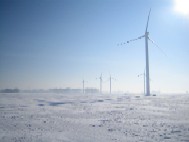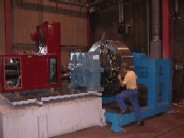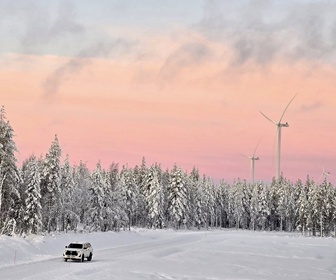- Category: Articles
Electricity Storage and Offshore Wind Energy
 How do you make sure that the supply of electricity always matches the fluctuating demand? Market liberalisation and the increasing prevalence of wind turbines and other widely distributed variable-output production units mean that this is one of the most pressing questions facing the energy industry today. The temporary storage of electricity in batteries or on an energy island may be the answer.
How do you make sure that the supply of electricity always matches the fluctuating demand? Market liberalisation and the increasing prevalence of wind turbines and other widely distributed variable-output production units mean that this is one of the most pressing questions facing the energy industry today. The temporary storage of electricity in batteries or on an energy island may be the answer.By Frits Verheij and Mereille Schreurs, KEMA, The Netherlands
.- Category: Articles
A New Challenge for Tried and Tested Technology
 With rapid growth in the wind energy industry, the demand for wind turbines is increasing throughout the world, including regions subject to extreme climatic conditions. LTi REEnergy has produced PITCH system solutions to meet the challenges of offshore, cold and hot climates. This article describes the company's cold climate version (CCV) of the PITCH system.
With rapid growth in the wind energy industry, the demand for wind turbines is increasing throughout the world, including regions subject to extreme climatic conditions. LTi REEnergy has produced PITCH system solutions to meet the challenges of offshore, cold and hot climates. This article describes the company's cold climate version (CCV) of the PITCH system.By Jens Ograbek, LTi REEnergy GmbH, Germany
.- Category: Articles
A New Type of Direct-Drive Generator
 The NewGen is a new type of direct-drive generator for wind turbines, based on the idea of putting the generator bearings adjacent to the air-gap of a large diameter generator. In this way the stiffness requirements of the rotor and the stator are drastically reduced, which leads to large mass savings in the mechanical structure.? These savings then enable a further diameter increase, which leads to further mass reductions in electrically active parts. The design is based on excitation by use of permanent magnets. So far a 140kW pilot-scale generator has been tested with encouraging results. The next step is a full-scale demonstration in a wind turbine. The development is taking place in cooperation with VG Power AB, Vasteras, Sweden.
The NewGen is a new type of direct-drive generator for wind turbines, based on the idea of putting the generator bearings adjacent to the air-gap of a large diameter generator. In this way the stiffness requirements of the rotor and the stator are drastically reduced, which leads to large mass savings in the mechanical structure.? These savings then enable a further diameter increase, which leads to further mass reductions in electrically active parts. The design is based on excitation by use of permanent magnets. So far a 140kW pilot-scale generator has been tested with encouraging results. The next step is a full-scale demonstration in a wind turbine. The development is taking place in cooperation with VG Power AB, Vasteras, Sweden.By Staffan Engström, Independent Consultant, Agir Konsult AB, Sweden
- Category: Articles
Maximising the Value of Wind Energy
 Wind energy remains the front-runner in the increased use of renewable energy. In the quest for cost-efficient wind energy, the constant availability of strong winds is crucial for every project. This is why, after coastal regions and high mountains, it is important to explore, develop and install near-shore and offshore wind projects. The first 2MW onshore turbines suffered from transformer reliability concerns around 2002. The problems due to vibrations, electric switching surges and overloading were investigated and designs were changed accordingly. Since 2004, step by step, wind energy has increasingly moved offshore.? Again, some reliability concerns were discovered and equipment was replaced. This article summarises the need for higher specifications and more reliable transformers in order to prepare the wind industry business for sustainable growth in offshore multi-megawatt turbines.
Wind energy remains the front-runner in the increased use of renewable energy. In the quest for cost-efficient wind energy, the constant availability of strong winds is crucial for every project. This is why, after coastal regions and high mountains, it is important to explore, develop and install near-shore and offshore wind projects. The first 2MW onshore turbines suffered from transformer reliability concerns around 2002. The problems due to vibrations, electric switching surges and overloading were investigated and designs were changed accordingly. Since 2004, step by step, wind energy has increasingly moved offshore.? Again, some reliability concerns were discovered and equipment was replaced. This article summarises the need for higher specifications and more reliable transformers in order to prepare the wind industry business for sustainable growth in offshore multi-megawatt turbines.By Dr Jan Declercq and Raymond Van Schevensteen, Pauwels International NV, Belgium
.- Category: Articles
Making Offshore Access as Easy as Crossing the Street
 Accessing offshore wind turbines is critical to keep all systems running. This is especially true when the weather deteriorates, wind speeds pick up and production can be maximised. But offshore these conditions also mean that wave heights increase and access by boat can become impossible. The Ampelmann has been developed to increase the accessibility from a ship, even in high wave conditions. The system uses six hydraulic cylinders (also used in flight simulators) to support a transfer deck and gangway. By measuring the ship motions continuously and controlling the length of the cylinders, the transfer deck stands completely still compared to the wind turbine. Access to the turbine then becomes 'as easy as crossing the street'.
Accessing offshore wind turbines is critical to keep all systems running. This is especially true when the weather deteriorates, wind speeds pick up and production can be maximised. But offshore these conditions also mean that wave heights increase and access by boat can become impossible. The Ampelmann has been developed to increase the accessibility from a ship, even in high wave conditions. The system uses six hydraulic cylinders (also used in flight simulators) to support a transfer deck and gangway. By measuring the ship motions continuously and controlling the length of the cylinders, the transfer deck stands completely still compared to the wind turbine. Access to the turbine then becomes 'as easy as crossing the street'.By Jan van der Tempel and David Cerda Salzmann, Delft University of Technology Offshore Engineering, the Netherlands
- Category: Articles
Using UAVs for Wind Resource Estimation
 Aerial photography can be of great value in the planning process for wind farms, including tasks such as wind resource estimation, verification of area maps and finding routes for transportation. However, this can be a rather expensive tool. A system has been developed to use a small unmanned air vehicle (UAV) to perform such photography tasks by using automated optimised routing and piloting. The goal was to allow inexperienced model airplane pilots to perform aerial photography with the required precision. This article explains the concepts, and the UAV hardware and system software developed within the project, which was conducted at Overspeed GmbH & Co. KG.
Aerial photography can be of great value in the planning process for wind farms, including tasks such as wind resource estimation, verification of area maps and finding routes for transportation. However, this can be a rather expensive tool. A system has been developed to use a small unmanned air vehicle (UAV) to perform such photography tasks by using automated optimised routing and piloting. The goal was to allow inexperienced model airplane pilots to perform aerial photography with the required precision. This article explains the concepts, and the UAV hardware and system software developed within the project, which was conducted at Overspeed GmbH & Co. KG.
By Felix Dierich and Dr Hans-Peter (Igor) Waldl, Overspeed, Germany
.- Wind Turbine Aerodynamics Using CFD
- Steps Towards Lightweight Direct-Drive Generators
- Fracture Mechanics and Wind Turbine Blades
- A Needed Change in Orientation
- Is Damage Tolerance the Future?
- Introduction to 3D Landscape Tools
- The Physics Behind Wind Measurement
- Lightning Protection of Wind Turbines
- Monitoring and Condition Inspections of Wind Turbines
- The Technology of the 200-Metre Met Mast
- In Defence of the Wind
- Comprehensive Solution with Added Value
- Hull (Massachusetts, USA) Offshore Wind Project
- Wind Resource Measurement by Laser Anemometry
- Filling a Need for a New Tower Design
- Improvements in Wind Power Prediction
- What's Your Transformer Got in the Tank?
- Financing Wind in Eastern Europe
- Dispatchable Wind
- The AXTRA Turbine
- Maritime and Marine Risk Assessment of Calamitous Oil Spills
- Motorwind
- Cracks at Foundations
- Predictive Maintenance Services
- Long-Duration Wind (Aero) Generator Back-Up
- Magenn Air Rotor System (MARS)
- Energy Prediction Uncertainty
- Demand Response
- Can Wind Energy and Radio Co-exist?
- Wind Power Generation in Sri Lanka










